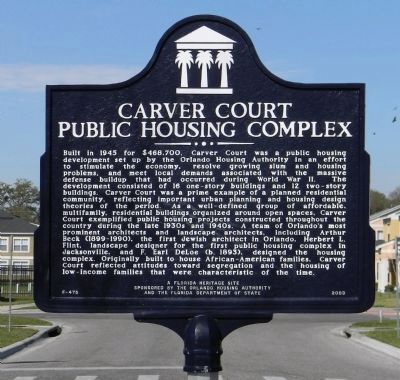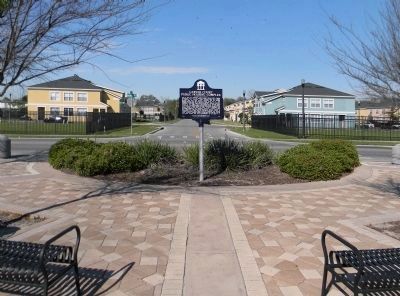Orlando in Orange County, Florida — The American South (South Atlantic)
Carver Court Public Housing Complex
Built in 1945 for $468,700, Carver Court was a public housing development set up by the Orlando Housing Authority in an effort to stimulate the economy, resolve growing slum and housing problems, and meet local demands associated with the massive defense buildup that had occurred during World War II. The development consisted of 16 one-story buildings and 12 two-story buildings. Carver Court was a prime example of a planned residential community, reflecting important urban planning and housing design theories of the period. As a well-defined group of affordable, multi-family, residential buildings organized around open spaces, Carver Court exemplified public housing projects constructed throughout the country during the late 1930s and 1940s. A team of Orlando’s most prominent architects and landscape architects, including Arthur Beck (1899-1990), the first Jewish architect in Orlando, Herbert L. Flint, landscape designer for the first public housing complex in Jacksonville, and F. Earl DeLoe (b. 1893), designed the housing complex. Originally built to house African-American families, Carver Court reflected attitudes toward segregation and the housing of low-income families that were characteristic of the time.
Erected 2003 by Orlando Housing Authority and the Florida Department of State . (Marker Number F-475.)
Topics. This historical marker is listed in these topic lists: African Americans • Civil Rights. A significant historical year for this entry is 1945.
Location. 28° 31.927′ N, 81° 23.577′ W. Marker is in Orlando, Florida, in Orange County. Marker is at the intersection of South Westmoreland Street and Cypress Street, on the right when traveling north on South Westmoreland Street. The marker is located in Carver Park, on South Westmoreland Street overlook at the lake. Touch for map. Marker is in this post office area: Orlando FL 32805, United States of America. Touch for directions.
Other nearby markers. At least 8 other markers are within walking distance of this marker. A different marker also named Carver Court Public Housing Complex (about 300 feet away, measured in a direct line); Mount Pleasant Baptist Church (approx. half a mile away); Hankins Building (approx. half a mile away); The Lynching of Arthur Henry / Racial Violence in America (approx. 0.6 miles away); Wells' Built Hotel (approx. 0.6 miles away); Holden-Parramore Historic District (approx. 0.6 miles away); The Barrier Breakers (approx. 0.8 miles away); The Mighty Trees of Lake Lorna Doone (approx. 0.8 miles away). Touch for a list and map of all markers in Orlando.
Regarding Carver Court Public Housing Complex. The last buildings of Carver Court were demolished in 2001. The Orlando Housing
Authority Carver Park HOPE VI community now occupies the site.
Also see . . . Carver Court Residents Can Start Packing. Orlando Sentinel website entry (Submitted on March 17, 2014, by PaulwC3 of Northern, Virginia.)
Credits. This page was last revised on December 5, 2021. It was originally submitted on March 17, 2014, by PaulwC3 of Northern, Virginia. This page has been viewed 667 times since then and 40 times this year. Photos: 1, 2. submitted on March 17, 2014, by PaulwC3 of Northern, Virginia.

